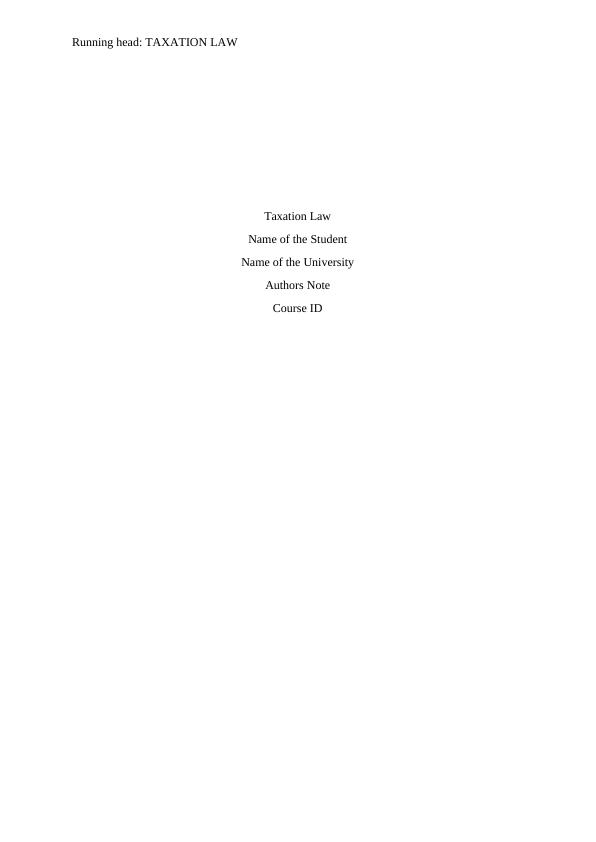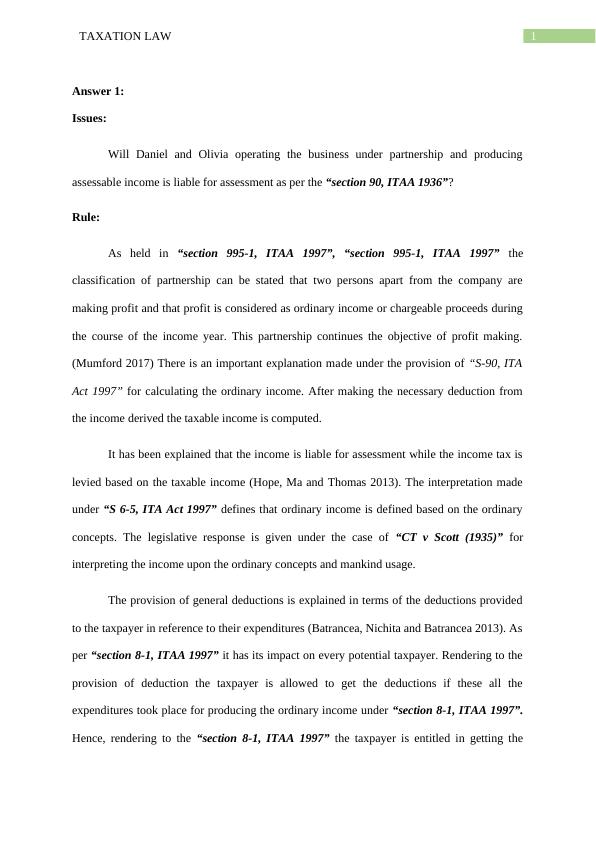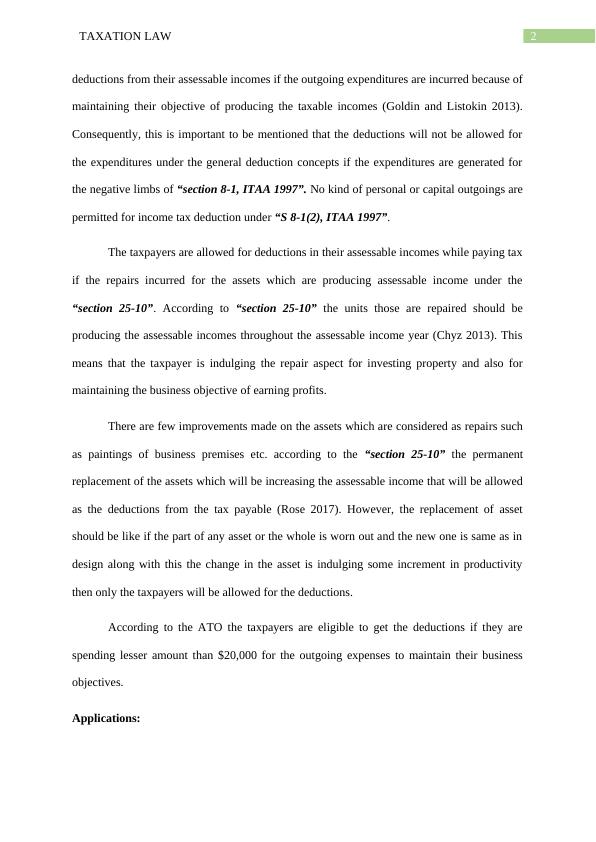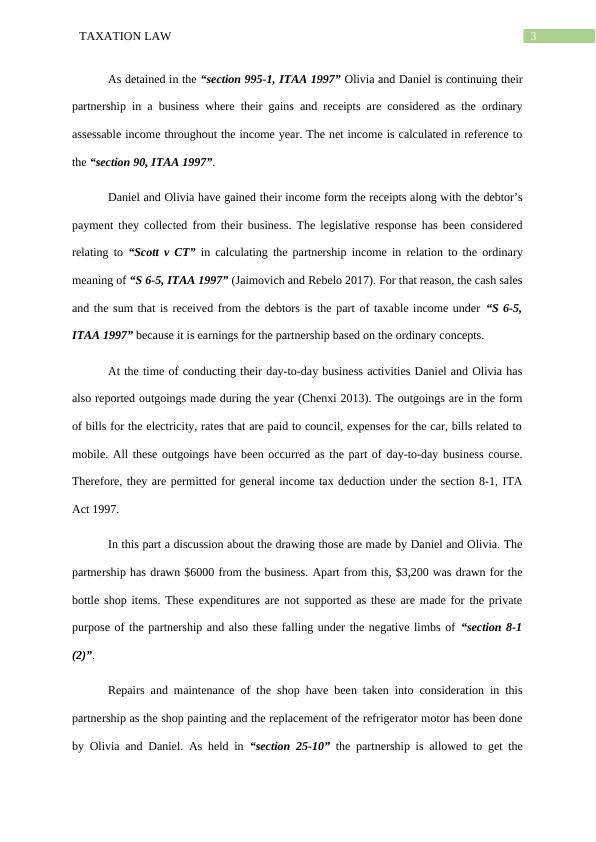Taxation Law: Calculation of Fringe Benefit Tax and Partnership Income
Added on 2023-04-22
11 Pages2162 Words359 Views
Running head: TAXATION LAW
Taxation Law
Name of the Student
Name of the University
Authors Note
Course ID
Taxation Law
Name of the Student
Name of the University
Authors Note
Course ID

1TAXATION LAW
Answer 1:
Issues:
Will Daniel and Olivia operating the business under partnership and producing
assessable income is liable for assessment as per the “section 90, ITAA 1936”?
Rule:
As held in “section 995-1, ITAA 1997”, “section 995-1, ITAA 1997” the
classification of partnership can be stated that two persons apart from the company are
making profit and that profit is considered as ordinary income or chargeable proceeds during
the course of the income year. This partnership continues the objective of profit making.
(Mumford 2017) There is an important explanation made under the provision of “S-90, ITA
Act 1997” for calculating the ordinary income. After making the necessary deduction from
the income derived the taxable income is computed.
It has been explained that the income is liable for assessment while the income tax is
levied based on the taxable income (Hope, Ma and Thomas 2013). The interpretation made
under “S 6-5, ITA Act 1997” defines that ordinary income is defined based on the ordinary
concepts. The legislative response is given under the case of “CT v Scott (1935)” for
interpreting the income upon the ordinary concepts and mankind usage.
The provision of general deductions is explained in terms of the deductions provided
to the taxpayer in reference to their expenditures (Batrancea, Nichita and Batrancea 2013). As
per “section 8-1, ITAA 1997” it has its impact on every potential taxpayer. Rendering to the
provision of deduction the taxpayer is allowed to get the deductions if these all the
expenditures took place for producing the ordinary income under “section 8-1, ITAA 1997”.
Hence, rendering to the “section 8-1, ITAA 1997” the taxpayer is entitled in getting the
Answer 1:
Issues:
Will Daniel and Olivia operating the business under partnership and producing
assessable income is liable for assessment as per the “section 90, ITAA 1936”?
Rule:
As held in “section 995-1, ITAA 1997”, “section 995-1, ITAA 1997” the
classification of partnership can be stated that two persons apart from the company are
making profit and that profit is considered as ordinary income or chargeable proceeds during
the course of the income year. This partnership continues the objective of profit making.
(Mumford 2017) There is an important explanation made under the provision of “S-90, ITA
Act 1997” for calculating the ordinary income. After making the necessary deduction from
the income derived the taxable income is computed.
It has been explained that the income is liable for assessment while the income tax is
levied based on the taxable income (Hope, Ma and Thomas 2013). The interpretation made
under “S 6-5, ITA Act 1997” defines that ordinary income is defined based on the ordinary
concepts. The legislative response is given under the case of “CT v Scott (1935)” for
interpreting the income upon the ordinary concepts and mankind usage.
The provision of general deductions is explained in terms of the deductions provided
to the taxpayer in reference to their expenditures (Batrancea, Nichita and Batrancea 2013). As
per “section 8-1, ITAA 1997” it has its impact on every potential taxpayer. Rendering to the
provision of deduction the taxpayer is allowed to get the deductions if these all the
expenditures took place for producing the ordinary income under “section 8-1, ITAA 1997”.
Hence, rendering to the “section 8-1, ITAA 1997” the taxpayer is entitled in getting the

2TAXATION LAW
deductions from their assessable incomes if the outgoing expenditures are incurred because of
maintaining their objective of producing the taxable incomes (Goldin and Listokin 2013).
Consequently, this is important to be mentioned that the deductions will not be allowed for
the expenditures under the general deduction concepts if the expenditures are generated for
the negative limbs of “section 8-1, ITAA 1997”. No kind of personal or capital outgoings are
permitted for income tax deduction under “S 8-1(2), ITAA 1997”.
The taxpayers are allowed for deductions in their assessable incomes while paying tax
if the repairs incurred for the assets which are producing assessable income under the
“section 25-10”. According to “section 25-10” the units those are repaired should be
producing the assessable incomes throughout the assessable income year (Chyz 2013). This
means that the taxpayer is indulging the repair aspect for investing property and also for
maintaining the business objective of earning profits.
There are few improvements made on the assets which are considered as repairs such
as paintings of business premises etc. according to the “section 25-10” the permanent
replacement of the assets which will be increasing the assessable income that will be allowed
as the deductions from the tax payable (Rose 2017). However, the replacement of asset
should be like if the part of any asset or the whole is worn out and the new one is same as in
design along with this the change in the asset is indulging some increment in productivity
then only the taxpayers will be allowed for the deductions.
According to the ATO the taxpayers are eligible to get the deductions if they are
spending lesser amount than $20,000 for the outgoing expenses to maintain their business
objectives.
Applications:
deductions from their assessable incomes if the outgoing expenditures are incurred because of
maintaining their objective of producing the taxable incomes (Goldin and Listokin 2013).
Consequently, this is important to be mentioned that the deductions will not be allowed for
the expenditures under the general deduction concepts if the expenditures are generated for
the negative limbs of “section 8-1, ITAA 1997”. No kind of personal or capital outgoings are
permitted for income tax deduction under “S 8-1(2), ITAA 1997”.
The taxpayers are allowed for deductions in their assessable incomes while paying tax
if the repairs incurred for the assets which are producing assessable income under the
“section 25-10”. According to “section 25-10” the units those are repaired should be
producing the assessable incomes throughout the assessable income year (Chyz 2013). This
means that the taxpayer is indulging the repair aspect for investing property and also for
maintaining the business objective of earning profits.
There are few improvements made on the assets which are considered as repairs such
as paintings of business premises etc. according to the “section 25-10” the permanent
replacement of the assets which will be increasing the assessable income that will be allowed
as the deductions from the tax payable (Rose 2017). However, the replacement of asset
should be like if the part of any asset or the whole is worn out and the new one is same as in
design along with this the change in the asset is indulging some increment in productivity
then only the taxpayers will be allowed for the deductions.
According to the ATO the taxpayers are eligible to get the deductions if they are
spending lesser amount than $20,000 for the outgoing expenses to maintain their business
objectives.
Applications:

3TAXATION LAW
As detained in the “section 995-1, ITAA 1997” Olivia and Daniel is continuing their
partnership in a business where their gains and receipts are considered as the ordinary
assessable income throughout the income year. The net income is calculated in reference to
the “section 90, ITAA 1997”.
Daniel and Olivia have gained their income form the receipts along with the debtor’s
payment they collected from their business. The legislative response has been considered
relating to “Scott v CT” in calculating the partnership income in relation to the ordinary
meaning of “S 6-5, ITAA 1997” (Jaimovich and Rebelo 2017). For that reason, the cash sales
and the sum that is received from the debtors is the part of taxable income under “S 6-5,
ITAA 1997” because it is earnings for the partnership based on the ordinary concepts.
At the time of conducting their day-to-day business activities Daniel and Olivia has
also reported outgoings made during the year (Chenxi 2013). The outgoings are in the form
of bills for the electricity, rates that are paid to council, expenses for the car, bills related to
mobile. All these outgoings have been occurred as the part of day-to-day business course.
Therefore, they are permitted for general income tax deduction under the section 8-1, ITA
Act 1997.
In this part a discussion about the drawing those are made by Daniel and Olivia. The
partnership has drawn $6000 from the business. Apart from this, $3,200 was drawn for the
bottle shop items. These expenditures are not supported as these are made for the private
purpose of the partnership and also these falling under the negative limbs of “section 8-1
(2)”.
Repairs and maintenance of the shop have been taken into consideration in this
partnership as the shop painting and the replacement of the refrigerator motor has been done
by Olivia and Daniel. As held in “section 25-10” the partnership is allowed to get the
As detained in the “section 995-1, ITAA 1997” Olivia and Daniel is continuing their
partnership in a business where their gains and receipts are considered as the ordinary
assessable income throughout the income year. The net income is calculated in reference to
the “section 90, ITAA 1997”.
Daniel and Olivia have gained their income form the receipts along with the debtor’s
payment they collected from their business. The legislative response has been considered
relating to “Scott v CT” in calculating the partnership income in relation to the ordinary
meaning of “S 6-5, ITAA 1997” (Jaimovich and Rebelo 2017). For that reason, the cash sales
and the sum that is received from the debtors is the part of taxable income under “S 6-5,
ITAA 1997” because it is earnings for the partnership based on the ordinary concepts.
At the time of conducting their day-to-day business activities Daniel and Olivia has
also reported outgoings made during the year (Chenxi 2013). The outgoings are in the form
of bills for the electricity, rates that are paid to council, expenses for the car, bills related to
mobile. All these outgoings have been occurred as the part of day-to-day business course.
Therefore, they are permitted for general income tax deduction under the section 8-1, ITA
Act 1997.
In this part a discussion about the drawing those are made by Daniel and Olivia. The
partnership has drawn $6000 from the business. Apart from this, $3,200 was drawn for the
bottle shop items. These expenditures are not supported as these are made for the private
purpose of the partnership and also these falling under the negative limbs of “section 8-1
(2)”.
Repairs and maintenance of the shop have been taken into consideration in this
partnership as the shop painting and the replacement of the refrigerator motor has been done
by Olivia and Daniel. As held in “section 25-10” the partnership is allowed to get the

End of preview
Want to access all the pages? Upload your documents or become a member.
Related Documents
Taxation Law: Partnership Net Income and Fringe Benefits Taxlg...
|12
|2589
|64
Taxation Law Name of the University Authorslg...
|12
|2626
|241
Taxation Law Case Study: Determination of Partnership Net Income, Expenses, and Deductionslg...
|13
|2530
|341
Taxation Law: Partnership Net Income and Expense Payment Fringe Benefitlg...
|12
|2661
|103
Taxation Law: Calculation of Net Income from Partnership and Fringe Benefit Taxationlg...
|13
|2590
|334
Taxation Lawlg...
|11
|2304
|498
